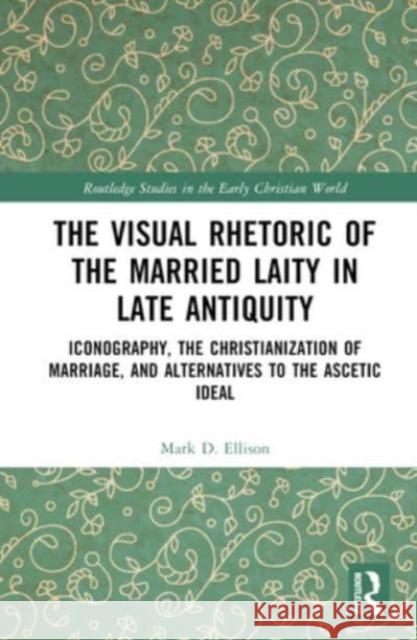The Visual Rhetoric of the Married Laity in Late Antiquity » książka



The Visual Rhetoric of the Married Laity in Late Antiquity
ISBN-13: 9781032546483 / Twarda / 2023 / 400 str.
The Visual Rhetoric of the Married Laity in Late Antiquity
ISBN-13: 9781032546483 / Twarda / 2023 / 400 str.
(netto: 672,22 VAT: 5%)
Najniższa cena z 30 dni: 654,86
ok. 22 dni roboczych.
Darmowa dostawa!
This study examines third- and fourth-century portraits of married Christians and associated images, reading them as visual rhetoric in early Christian conversations about marriage and celibacy, and recovering lay perspectives underrepresented in literary sources.
Wydanie ilustrowane
"In Late Antiquity, many Christian leaders expressed a negative view of the married life of the laity. They preferred to support monks and to praise virgins. In this learned and thought-provoking book, Mark Ellison modifies the gloomy impression left by their writings. He shows that the shrill radicalism of the few was held in check by innumerable silent choices that can be seen in the iconography of Early Christian sarcophagi, in marriage poems and funeral addresses, and in the twinkling light of the gold glass cups and medallions scattered throughout the catacombs of Rome and elsewhere. He has brought into the light (often, literally from underground) evidence for a gentler Christianity, more widespread and more respectful of married love than we had expected." - Peter Brown, Professor of History Emeritus, Princeton University.
"I highly recommend this excellent and very important book! Its approach to the “visual rhetoric” of early Christianity is highly original. There is really nothing like it in the existing scholarship. The book will be of great interest to classicists, historians, and scholars of early Christianity in late antiquity. Moreover, it is elegantly written, beautifully illustrated, and cogently argued." - David G. Hunter, Margaret O'Brien Flatley Professor of Catholic Theology, Boston College.
"Ellison’s highly recommended, richly illustrated, and fascinating book opens a window onto the aspirations and expectations of those “ordinary” Christians that history books often overlook. By drawing upon evidence that text-based studies typically miss, this volume both shines new light on the past and serves as model of how to integrate material artifacts and iconography with documentary evidence to gain insight into lived religious practices of average folks that survive as much in objects and images as in words." - Robin M. Jensen, Patrick O'Brien Professor of Theology, University of Notre Dame.
"With careful judgment and consummate skill, Ellison seeks out in the visual record the manifestation of the joys and sorrows of normal marriage and family life in Rome of the third and fourth centuries, as well as the expectations of these faithful believers for something beyond mortal life. Under the voices of the loud minority of writers on the ascetic life that have so dominated our views of the era, he exposes in the material heritage aspects of the life of the majority of Christians who lived, married, died, and left their legacy for us to discover." - Carolyn Osiek, Charles Fischer Professor of New Testament, emerita, Brite Divinity School, Texas Christian University.
"Recent years have witnessed a salutary increase in efforts to recover what Carolyn Osiek has called “the silent majority” of early Christians—those that, unlike their ascetic contemporaries, married, begot children, and were in other ways part of Roman households. Thus far, much of the relevant scholarship, including seminal contributions like Kate Cooper’s and Lisa Bailey’s, has focused on the textual record. Mark Ellison’s new monograph, The Visual Rhetoric of the Married Laity in Late Antiquity, by contrast, offers readers a glimpse into material representations of married life during the first four centuries of the Common Era. By surveying sarcophagi, glass medallions, inscriptions, and a plethora of small objects that furnished the homes and burial spaces of Christians of all social classes, Ellison generates an engaging, nuanced, and approachable portrait of family culture during this crucial era of Christian development." - Maria Doerfler, Associate Professor of Late Antiquity, Yale University.
Prologue: The Monk and the Matrona; 1. Introduction: Recovering the Voices of “the Silent Majority”; 2. Competing Visions: Early Christian Thought on Marriage and Celibacy; 3. Centering Christ: Adaptations of dextrarum iunctio, Concordia pronuba, and coronae impositio in Spousal Portraits; 4. Learned, Encircled, Worshipping: Other Forms of Double-Portraits and Self-Representation; 5. In the Beginning: Married Christians Putting Adam and Eve to Work; 6. After the End: Marriage, Death, and the Afterlife; 7. Conclusion: Image and Word in the Conversations of the Christian Past; Appendix: Adam and Eve Images and Marital Contexts on Christian Sarcophagi.
Mark D. Ellison is an Associate Professor in the Department of Ancient Scripture at Brigham Young University in Provo, UT, USA. He co-edited The Routledge Handbook of Early Christian Art (with Robin M. Jensen) and Material Culture and Women’s Religious Experience in Antiquity.
1997-2026 DolnySlask.com Agencja Internetowa
KrainaKsiazek.PL - Księgarnia Internetowa









